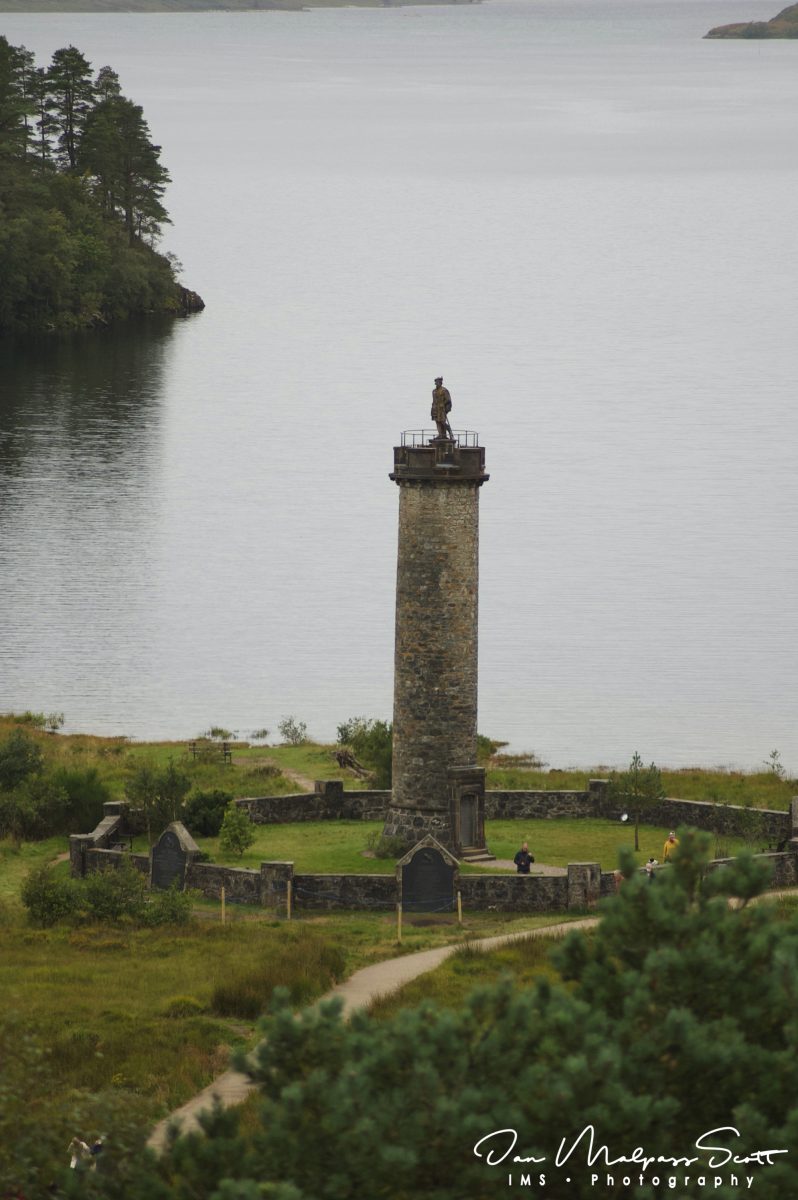Glenfinnan Monument & Loch Shiel, Glenfinnan, Highland
Jacobite rising
Prince Charles landed from France on Eriskay in the Western Isles, travelling to the mainland in a small rowing boat, coming ashore at Loch nan Uamh just west of Glenfinnan. On arrival on the Scottish mainland, he was met by a small number of MacDonalds. Stuart waited at Glenfinnan as more MacDonalds, Camerons, Macfies, and MacDonnells arrived.
On 19 August 1745, after Prince Charles judged he had enough military support, he climbed the hill near Glenfinnan as MacMaster of Glenaladale raised his royal standard. The Young Pretender announced to all the mustered clans he claimed the British throne in the name of his father James Stuart (‘the Old Pretender’). A MacPhee (Macfie) was one of two pipers with Bonnie Prince Charlie as he raised his banner above Glenfinnan. After claiming the throne, brandy was distributed to the assembled highlanders to celebrate the occasion.
Eight months later, the Jacobite claim to the throne ended in failure at the Battle of Culloden on 16 April 1746. Many Macfies from Glenfinnan followed Donald Cameron of Lochiel on the right flank of the Jacobite Army at the battle.
Charles Stuart returned to the area after Culloden during his flight to evade the Government troopers of Prince William, Duke of Cumberland. After taking refuge with loyal supporters, he boarded a French frigate on the shores of Loch nan Uamh close to where he landed and raised his standard the previous year. The Young Pretender died in Rome in 1788 without setting foot on Scottish soil again. The Prince’s Cairn marks the spot from where he departed into exile.
Monument
By 1815, the Jacobite cause was no longer a political threat to the Hanoverian monarchy. Alexander Macdonald of Glenaladale, a minor branch of the Clan Donald, built a memorial tower at Glenfinnan to commemorate the raising of the standard of the Young Pretender. The tower, which is 18 metres in height, was designed by the Scottish architect James Gillespie Graham. The statue of an anonymous highlander, referred to at the point of commission as Charles Edward Stewart, by John Greenshields, was added in 1835.
The monument’s location at Glenfinnan was made possible because of an 1812 new road, now the A830 road, built by Thomas Telford, opened between Fort William to Arisaig.
Since 1938, the Glenfinnan Monument has been in the care of the National Trust for Scotland. The Trust constructed a visitor centre, providing tickets, information, exhibitions, a shop, café, and toilets. The tower is also a monument to Alexander Macdonald, but he perished before its completion. Jacobite enthusiasts gather at the tower each year on 19 August to remember the Rising of ’45.
Loch Shiel
Loch Shiel (Scottish Gaelic: Loch Seile) is a freshwater loch situated 20 kilometres (12 mi) west of Fort William in the Highland council area of Scotland. At 28 kilometres (17 1⁄2 mi) long it is the 4th longest loch in Scotland, and is the longest to have retained a natural outflow without any regulation of its water level, being 120 m (393 ft) deep. Its nature changes considerably along its length, being deep and enclosed by mountains in the north east and shallow surrounded by bog and rough pasture in the south west, from which end the 4 km River Shiel drains to the sea in Loch Moidart near Castle Tioram.
The surrounding highlands are picturesque but relatively rarely climbed as none quite reaches the 3,000 ft (910 m) required for Munro status.[A number of the hills are classified as Corbetts, including Beinn Resipol, Sgùrr Ghiubhsachain and Sgorr Craobh a’ Chaorainn on the southern side of the loch; and Beinn Odhar Bheag on the northern side. The area is well wooded compared to the many Highland areas that have suffered from overgrazing. The view of the loch looking south from the Glenfinnan monument, showing wooded hillsides with bare summits rising steeply from a fjord-like loch, has become one of the most famous images of the Scottish Highlands. Several major films have used the loch for location shooting.
Loch Shiel is less than 10 metres above sea level, and was formed at the end of the last ice age when glacial deposits blocked what was formerly a sea loch.


